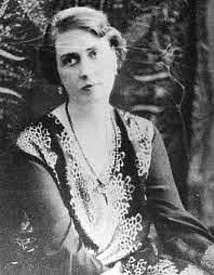Carin Göring
| Carin Göring | |
|---|---|
|
Carin Göring | |
| Born |
Carin Axelina Hulda Fock 21 October 1888 Stockholm, Sweden |
| Died |
17 October 1931 (aged 42) Stockholm, Sweden |
| Cause of death | Myocardial infarction |
| Resting place |
Lovö Kyrka, Lovön, Sweden 59°19′16.71″N 17°50′23.28″E / 59.3213083°N 17.8398000°ECoordinates: 59°19′16.71″N 17°50′23.28″E / 59.3213083°N 17.8398000°E |
| Nationality | Swedish |
| Other names | Carin von Kantzow |
| Spouse(s) |
|
| Children | Thomas von Kantzow |
| Parent(s) |
|
| Relatives | Mary von Rosen (sister) |
Carin Axelina Hulda Göring (21 October 1888 – 17 October 1931) was the Swedish first wife of Hermann Göring.
Biography
She was born Carin Axelina Hulda Fock in Stockholm in 1888. Her father, Baron Carl Fock, was a Swedish Army colonel, from a family which had emigrated to Sweden from Westphalia. Her mother, whose maiden name was Huldine Beamish, was born in 1860 into an Anglo-Irish family famous for brewing Beamish and Crawford stout in Cork. Her great-great grandfather, William Beamish, was one of the founders of Beamish and Crawford, and her grandfather had served in Britain's Coldstream Guards. Carin's maternal grandmother had founded a private religious sisterhood, the Edelweiss Society. She was the fourth of five daughters; her sisters were Fanny von Wilamowitz-Moellendorff (1882-1956), Mary von Rosen (born 1886), Elsa, and Lily. Mary (1886–1967) was married to Count Eric von Rosen (1879–1948), one of the founding members of the Nationalsocialistiska Blocket ("National Socialist Bloc"), a Swedish National Socialist political party.
She became Carin von Kantzow upon her marriage in 1910 to a Swedish army officer, Baron Niels Gustav von Kantzow. Their only child, Thomas von Kantzow, was born in 1913.
In 1920, while she was estranged from her first husband, Carin met Hermann Göring at Rockelstad Castle while she was visiting her sister Mary. Four years younger than she, he was working in Sweden as a commercial pilot for the short-lived airline Svensk Lufttrafik and was at the castle because he had flown Count Eric von Rosen, her sister Mary's husband, there. Goering fell in love with Carin and soon started meeting her in Stockholm, despite the fact, scandalous at the time, that she was a separated woman with a young child. She was divorced from Kantzow in December 1922 and married Göring on 3 January 1923.[1]
After their marriage, the Görings first lived in a house in the suburbs of Munich. Carin followed her husband and became a member of the Nazi Party.[2] When Göring was badly injured in the groin while marching alongside Hitler in the failed Beer Hall Putsch in November 1923, Carin took him to Austria, then on to Italy, and nursed him back to health,[3] Carin and Göring's romantic love-story was used by the propaganda machine of Goebbels and the couple toured around the nation to boost the popularity of the Nazi Party.[1]
Carin suffered from tuberculosis during her later years. When her mother, Huldine Fock, died unexpectedly on 25 September 1931, it came as a great shock to the 42-year-old Carin. Although her health was still fragile, she went to Sweden for her mother's funeral.[4] The next day, she suffered a heart attack in Stockholm. On the news reaching Göring, he joined her there and stayed with her until she died of heart failure on 17 October 1931, four days before her 43rd birthday.[4][5]
After her death, Carin's older sister Fanny wrote a biography of her which quickly became a bestseller in Germany. By 1943, it had sold 900,000 copies.
Carin's death came as a great blow to Göring. In 1933 he began to build a hunting lodge, which became his main home, and named it Carinhall in her honour. It was there that he had her body re-interred from her original grave in Sweden, in a funeral attended by Adolf Hitler. Göring filled Carinhall with images of Carin, as he did his flat in Berlin, where he created an altar in memory of her which remained even after he remarried in 1935. Carinhall was demolished on Göring's orders as Soviet troops advanced in 1945.
Following the war, remains believed to be those of Carin were recovered by the Fock family, cremated, and re-buried in Sweden. In 1991, remains were found that could also be Carin Göring's and were sent to Sweden for identification. Evidence suggested that these new remains were those of Carin Göring, and have now been reburied.[6]
References
- 1 2 "Hermann Göring and Carin Göring". Rockelstad Castle. 2009. Retrieved 13 April 2012.
- ↑ Find a Grave: Carin Göring
- ↑ "Biography of Carin Goering with WWII-dated inscription and signature by Nazi Reichmarshal Hermann Goering". History In Ink. 2012. Retrieved 13 April 2012.
- 1 2 Joseph Howard Tyson (21 September 2010). The Surreal Reich. iUniverse. p. 295. ISBN 978-1-4502-4019-2. Retrieved 16 September 2012.
- ↑ Riccini, Elisabeth Braw (14 February 2002). "Carin Göring – Nazitysklands svenska ikon". Populär Historia (in Swedish). Retrieved 13 April 2012.
- ↑ Koffmar, Linda (21 December 2012). "Carin Göring's remains identified by researchers at Uppsala University". Uppsala Universitet. Uppsula University. Retrieved 4 January 2013.
